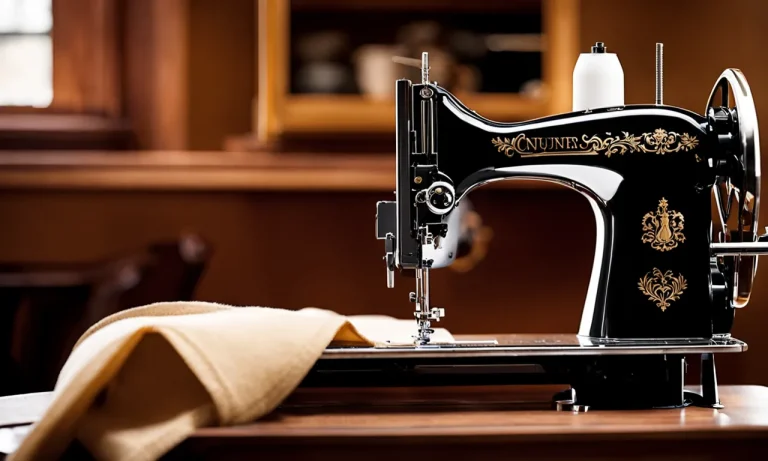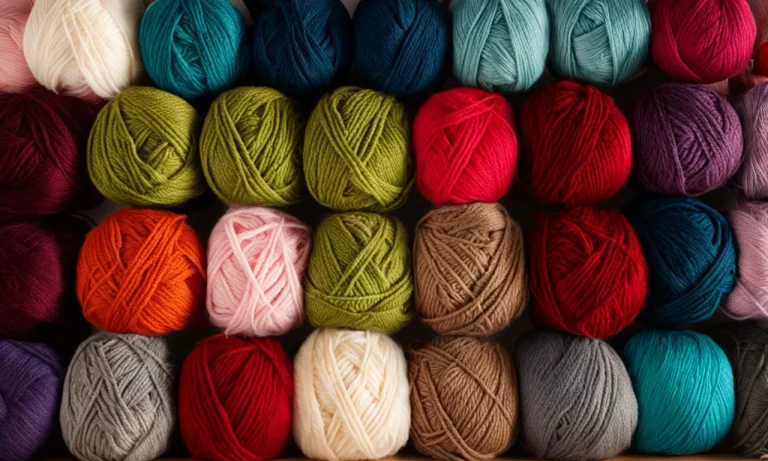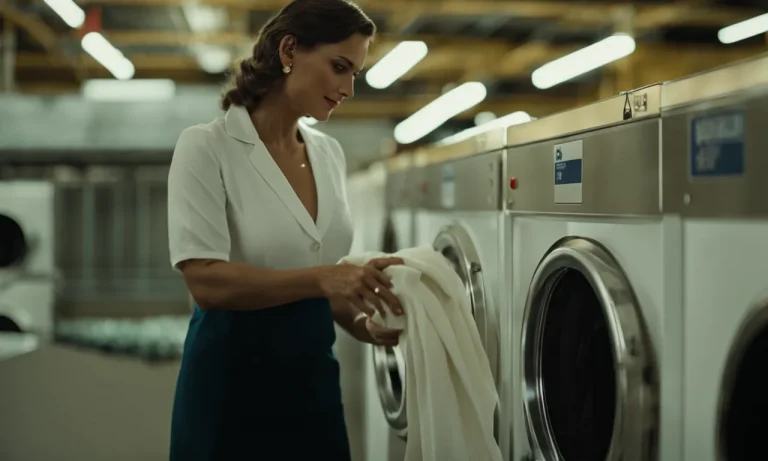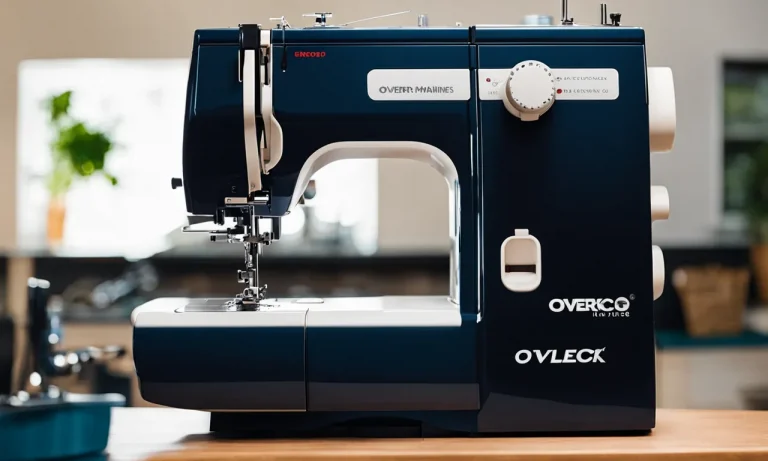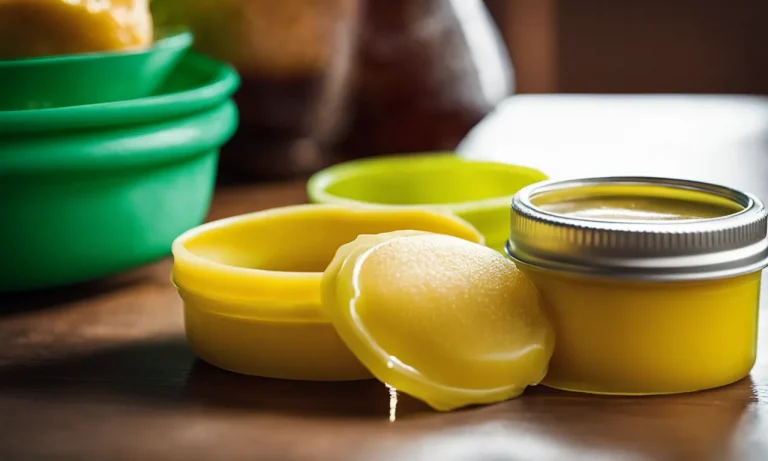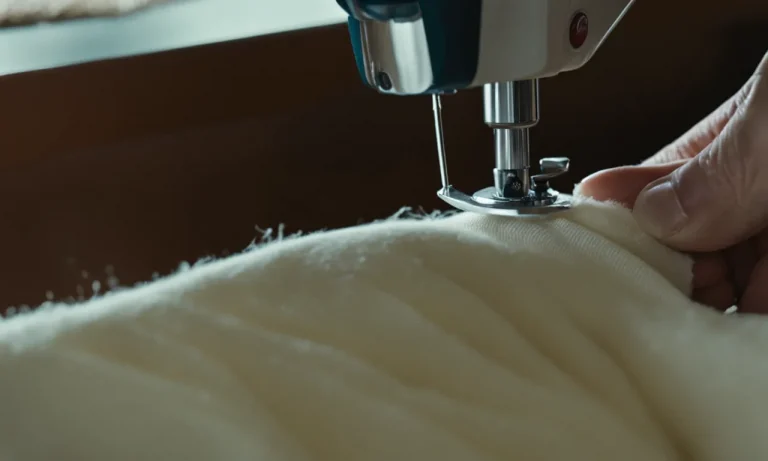How To Remove Sticky Trap Glue From Fabric: A Step-By-Step Guide
Getting sticky trap glue on your clothes or other fabric items can be incredibly annoying. That stubborn, gooey residue seems like it might never come out. If you’re short on time, here’s a quick answer to your question: use an oil like coconut or olive oil to soak the glue, then scrape off what you can before washing the fabric.
But don’t worry – with some time and effort, you can get even the most stuck-on sticky trap glue out of fabric.
In this comprehensive guide, we’ll walk through all the steps and techniques you need to remove sticky trap glue from fabric. We’ll cover different removal methods using household items you likely have on hand, like oils, ice cubes, nail polish remover, laundry detergent, vinegar and more.
We’ll also provide tips to deal with more delicate fabrics. By the end, you’ll have the confidence to tackle even the most stubborn sticky trap glue stains.
What You’ll Need
Oils like coconut, olive or vegetable oil
If you’re dealing with sticky trap glue on fabric, one of the most effective solutions is using oils like coconut, olive, or vegetable oil. These oils work by breaking down the adhesive properties of the glue, making it easier to remove from the fabric.
Simply apply a small amount of oil onto the affected area and gently rub it in. Let it sit for a few minutes to allow the oil to penetrate the glue. Then, using a clean cloth or paper towel, blot the area to lift the sticky residue. Repeat this process until the glue is completely removed.
Ice cubes
Another handy item to have when removing sticky trap glue from fabric is ice cubes. Freezing the glue can help harden it, making it easier to scrape off. Place a few ice cubes in a plastic bag and apply it to the affected area. Let it sit for a few minutes until the glue becomes brittle.
Then, using a blunt object like a spoon or a butter knife, gently scrape off the hardened glue. Be careful not to damage the fabric in the process. Once the majority of the glue is removed, you can use an oil or a cleaning solution to get rid of any remaining residue.
Nail polish remover
Nail polish remover is another effective option for removing sticky trap glue from fabric. Look for a nail polish remover that contains acetone, as this ingredient helps dissolve the adhesive. Apply a small amount of nail polish remover onto a clean cloth or cotton ball and dab it onto the affected area.
Gently blot the glue until it starts to loosen. Once the glue has softened, use a clean cloth to wipe away the residue. Remember to test the nail polish remover on a small, inconspicuous area of the fabric first to ensure it doesn’t cause any damage or discoloration.
Laundry detergent
If you prefer a gentler approach, you can try using laundry detergent to remove sticky trap glue from fabric. Mix a small amount of laundry detergent with warm water to create a soapy solution. Apply the mixture onto the affected area and gently rub it in using a brush or an old toothbrush.
Let it sit for a few minutes to allow the detergent to break down the glue. Then, rinse the fabric with warm water and pat it dry with a clean cloth. This method may require multiple applications for stubborn glue stains.
White vinegar
White vinegar is a versatile household item that can also be used to remove sticky trap glue from fabric. Mix equal parts of white vinegar and warm water in a spray bottle. Spray the solution onto the affected area and let it sit for a few minutes.
Use a clean cloth or sponge to gently blot the glue until it starts to dissolve. Rinse the fabric with water and pat it dry. If the glue residue persists, repeat the process or try using a different method.
Old toothbrush or other scrub brush
An old toothbrush or a scrub brush can be useful for scrubbing away sticky trap glue from fabric. After applying the chosen solution (such as oil, nail polish remover, laundry detergent, or vinegar), use the brush to gently scrub the affected area in circular motions.
This helps to loosen the glue and remove it from the fabric fibers. Be careful not to scrub too vigorously, as this can damage delicate fabrics. Always test the brush on a small, inconspicuous area of the fabric first to ensure it doesn’t cause any damage.
Rags, paper towels, or washcloths
To aid in the removal process, you’ll need some rags, paper towels, or washcloths. These absorbent materials are essential for blotting and wiping away the glue residue. After applying the chosen solution and allowing it to work its magic, use the rags, paper towels, or washcloths to gently blot the area and lift the sticky residue.
Make sure to use clean materials to avoid spreading the glue or causing further damage to the fabric.
Tweezers or sticky lint roller (optional)
If there are any stubborn bits of glue remaining on the fabric after using the above methods, you can try using tweezers or a sticky lint roller to pick them off. Tweezers allow for precise removal, while a sticky lint roller can be rolled over the fabric to pick up any leftover residue.
Use these tools with caution, especially on delicate fabrics, to avoid causing any damage.
Prep the Stained Fabric
Lay the fabric stain-side up on a flat surface.
Before you begin the process of removing sticky trap glue from fabric, it’s important to prep the stained fabric properly. Start by laying the fabric stain-side up on a flat surface. This will allow you to have better access to the stain and work on it more effectively.
Place paper towels or rags underneath to protect the surface.
To protect the surface underneath the fabric, it’s a good idea to place some paper towels or rags underneath. This will prevent any glue residue from seeping through and sticking to the surface. It also makes cleanup easier once you’re done removing the glue.
For heavy glue, try to scrape off any globs with tweezers or sticky lint roller first.
If the glue on the fabric is particularly heavy and has formed globs, it’s a good idea to try and scrape off as much of it as possible before proceeding with the removal process. You can use tweezers or a sticky lint roller to gently lift off the globs.
Be careful not to pull too hard, as this may damage the fabric.
For more detailed information on how to remove sticky trap glue from fabric, you can visit www.stain-removal-101.com. They provide step-by-step guides and tips on removing various types of stains, including glue stains, from different types of fabrics.
Apply Oil and Let Soak
Coconut, olive and vegetable oils work best for breaking down glue.
When it comes to removing sticky trap glue from fabric, using the right type of oil is crucial. Coconut, olive, and vegetable oils are known for their adhesive-breaking properties. These oils contain compounds that help dissolve the glue and make it easier to remove from the fabric.
So, make sure you have one of these oils on hand before you begin the removal process.
Thoroughly wet the glue stain with a liberal amount of oil.
Once you have the oil ready, it’s time to apply it to the glue stain. Take a clean cloth or sponge and saturate it with a liberal amount of oil. Then, gently dab or rub the cloth onto the glue stain, making sure to cover the entire affected area.
The oil will start to break down the glue, making it easier to remove from the fabric.
Let sit for at least 15 minutes so the oil can soak in.
After applying the oil, it’s important to give it some time to work its magic. Let the oil-soaked fabric sit for at least 15 minutes, allowing the oil to penetrate the glue and soften its grip on the fabric fibers. This soaking period is crucial for achieving the best results.
While you wait, you can take this time to prepare other materials or gather any additional tools you may need for the next steps.
Remember, it’s important to be patient during this process. Rushing the removal can lead to incomplete results, leaving behind traces of sticky residue. So, give the oil enough time to soak in and do its job effectively.
Use Ice to Freeze Glue
If you’re wondering how to remove sticky trap glue from fabric, one effective method is to use ice to freeze the glue. This technique can help solidify the glue, making it easier to remove without damaging the fabric. Here’s a step-by-step guide on how to do it:
For very thick glue, alternate soaking with oil and freezing with ice cubes.
If the glue on your fabric is particularly thick or stubborn, you may need to take some extra steps to break it down. One method is to alternate between soaking the area with oil and freezing it with ice cubes. Start by applying a small amount of oil, such as vegetable or olive oil, to the glue.
Let it sit for a few minutes to loosen the adhesive. Then, place an ice cube on top of the oil-soaked glue and press it down gently. The combination of the oil and the freezing temperature from the ice will help break down the glue and make it easier to remove.
The heating and cooling will help break down the glue.
The reason why freezing the glue works is because of the science behind heating and cooling. When glue is frozen, it becomes more brittle and less sticky. This allows you to scrape or peel it off more easily.
The cold temperature from the ice cube causes the glue to contract, making it easier to detach from the fabric fibers. Additionally, the moisture from the ice cube can help soften the glue, further facilitating its removal.
It’s important to note that this method may not work for all types of glue, so it’s always a good idea to test it on a small, inconspicuous area of the fabric first.
For more information and tips on removing sticky trap glue from fabric, you can visit stain-removal-101.com. They provide comprehensive guides on stain removal and offer helpful advice for various types of stains and fabrics.
Scrape Away Glue
When it comes to removing sticky trap glue from fabric, one of the first steps you can take is to scrape away the excess glue. There are several tools you can use for this task, such as an old toothbrush, a butter knife, tweezers, or even your fingernails.
However, it’s important to be gentle and cautious while scraping to avoid damaging the fabric underneath.
Use an old toothbrush, butter knife, tweezers or your fingernails to gently scrape at the glue.
Using an old toothbrush can be an effective way to remove sticky trap glue from fabric. Simply use the bristles of the toothbrush to gently scrape at the glue, working in small circular motions. The soft bristles of the toothbrush will help loosen the glue without causing any harm to the fabric.
Alternatively, you can also use a butter knife or tweezers to scrape away the glue. Just be sure to use these tools with caution and avoid applying too much pressure. If you prefer, you can also use your fingernails to carefully scrape at the glue.
However, make sure your nails are clean and trimmed to avoid any damage to the fabric.
Scrape slowly and carefully to avoid damaging the fabric underneath.
When scraping away the glue, it’s crucial to proceed slowly and with care. Applying too much force or scraping too quickly can lead to unintended damage to the fabric. Take your time and use gentle, controlled movements to remove the glue without causing any harm.
Keep applying more oil as needed to keep glue soft.
If the glue is particularly stubborn and difficult to remove, you can try using oil to soften it. Apply a small amount of oil, such as olive oil or coconut oil, to the affected area and let it sit for a few minutes. This will help loosen the glue, making it easier to scrape away.
Remember to apply more oil as needed to keep the glue soft and pliable.
Remember, when dealing with sticky trap glue on fabric, patience is key. Take your time, use the right tools, and be gentle while scraping. With these steps in mind, you’ll be able to effectively remove sticky trap glue from fabric without causing any damage.
Use Laundry Detergent
For smaller areas of glue, rub concentrated laundry detergent directly into the stain.
Laundry detergent is a powerful ally when it comes to removing sticky trap glue from fabric. Its surfactants help break down the adhesive properties of the glue, making it easier to remove. To tackle smaller areas of glue, start by applying a small amount of concentrated laundry detergent directly onto the stained area.
Use your fingers or a soft cloth to gently rub the detergent into the fabric. This will help loosen the glue and begin the removal process.
Let sit for 5-10 minutes before washing as usual.
After applying the laundry detergent, it’s important to let it sit on the fabric for a few minutes. This allows the detergent to penetrate the glue and further dissolve its adhesive properties. Give it about 5 to 10 minutes before proceeding to the next step.
Once the waiting period is over, you can proceed with washing the fabric as you normally would. Place the item in the washing machine and add the appropriate amount of laundry detergent. Follow the care instructions on the fabric label and set the machine to the recommended temperature.
By washing the fabric after treating it with laundry detergent, you’ll ensure that any remaining glue residue is completely eliminated.
Remember, it’s always a good idea to test the laundry detergent on a small, inconspicuous area of the fabric before applying it to the stained area. This will help you ensure that the detergent doesn’t cause any discoloration or damage to the fabric.
For more tips and tricks on removing stains from fabric, you can visit Cleanipedia.com, a reliable source for cleaning and stain removal information.
Try Nail Polish Remover
When it comes to removing sticky trap glue from fabric, one effective solution is to use acetone-based nail polish remover. This method works best for manmade fabrics like polyester, as acetone is known for its ability to dissolve adhesives.
Use acetone-based nail polish remover for glue on manmade fabrics like polyester.
If you have a sticky trap glue stain on a polyester fabric, acetone-based nail polish remover can be a great option to remove it. Simply apply a small amount of the nail polish remover to a clean cloth or cotton ball and gently dab it onto the glue stain.
Be sure to work from the outside of the stain toward the center to avoid spreading it further.
Spot test first to check for discoloration or damage.
Before applying the nail polish remover to the entire glue stain, it’s important to spot test a small, inconspicuous area of the fabric first. This will help you determine if the nail polish remover will cause any discoloration or damage to the fabric.
Apply a small amount of the nail polish remover to the spot and wait a few minutes to see if any adverse effects occur. If no discoloration or damage is observed, you can proceed with removing the glue stain.
Do not use on natural fabrics like cotton or silk.
While nail polish remover can be effective on manmade fabrics, it is not recommended for use on natural fabrics like cotton or silk. These fabrics are more delicate and can be easily damaged by the harsh chemicals in nail polish remover.
Instead, it is best to explore other methods specifically designed for removing sticky trap glue from natural fabrics.
For more information on fabric care and stain removal, you can visit websites like The Spruce or Good Housekeeping.
Clean with Vinegar
Vinegar is a versatile household ingredient that can be used for various cleaning purposes, including removing sticky trap glue from fabric. Its acidic nature makes it an effective solution for breaking down adhesive bonds.
Here are two steps to follow when using vinegar to clean sticky trap glue from fabric:
1. Soak in a vinegar solution for 30 minutes before washing.
To start the cleaning process, create a vinegar solution by mixing equal parts of vinegar and water. Submerge the affected fabric in the solution and let it soak for about 30 minutes. This allows the vinegar to penetrate the glue and loosen its grip on the fabric fibers.
Pro tip: For best results, use white vinegar as it is less likely to leave behind any residue or stains on the fabric.
2. The acetic acid in vinegar helps dissolve glue bonds.
The acetic acid in vinegar acts as a solvent, breaking down the adhesive properties of the glue. As the fabric soaks in the vinegar solution, the acid works to dissolve the glue bonds, making it easier to remove the sticky residue.
Caution: Before applying vinegar directly to the fabric, it is always a good idea to test it on a small, inconspicuous area to ensure it does not cause any damage or discoloration.
After the fabric has soaked for the recommended time, remove it from the vinegar solution and gently scrub the area with a soft brush or sponge to dislodge any remaining glue. Rinse the fabric thoroughly with water to remove any vinegar residue, and then wash it as usual.
Remember: Patience is key when removing sticky trap glue from fabric. It may take a few rounds of soaking and scrubbing to completely eliminate the sticky residue.
For more information on cleaning with vinegar, you can visit The Spruce, a trusted source for home cleaning tips and advice.
Finish with Laundering
Machine or hand wash the fabric after glue removal attempts.
Once you have successfully removed the sticky trap glue from your fabric, it is important to give it a thorough cleaning to ensure all traces of the glue are gone. You have two options for washing your fabric: either machine wash it or hand wash it.
If you choose to machine wash the fabric, make sure to follow the care instructions on the fabric label. Use a gentle cycle and cold water to prevent any damage to the fabric.
If you prefer to hand wash the fabric, fill a basin or sink with lukewarm water and add a small amount of mild detergent. Gently agitate the fabric in the soapy water, making sure to pay extra attention to the areas where the glue was present. Rinse the fabric thoroughly to remove any soap residue.
Use hot water and regular laundry detergent.
When laundering the fabric, it is best to use hot water and regular laundry detergent. Hot water helps to break down any remaining glue particles and ensures a deep clean. Regular laundry detergent is designed to remove stains and dirt effectively, making it a suitable choice for this task.
Make sure to read the instructions on the laundry detergent packaging and use the recommended amount for the load size. If the fabric is particularly delicate or requires special care, consider using a gentle or mild detergent specifically formulated for delicate fabrics.
Air dry, repeating laundering if needed.
After washing the fabric, avoid using a dryer as heat can set any remaining glue stains and make them more difficult to remove. Instead, opt for air drying the fabric. Hang it up or lay it flat on a clean surface, ensuring proper airflow to help it dry completely.
Once the fabric is dry, inspect it to see if any glue stains are still visible. If so, you may need to repeat the laundering process. Remember, it is essential to remove all traces of the glue to prevent it from damaging the fabric or causing discoloration over time.
For additional tips and tricks on fabric care and stain removal, you can visit websites like The Spruce or Good Housekeeping. These websites offer a wealth of information on various cleaning techniques and product recommendations to help you keep your fabrics looking their best.
Tips for Delicate Fabrics
Avoid nail polish remover on silk, wool and other delicate materials.
When trying to remove sticky trap glue from delicate fabrics such as silk or wool, it’s important to avoid using nail polish remover. Nail polish remover contains acetone, which can be too harsh for these delicate materials and may cause damage or discoloration.
Instead, opt for gentler solutions that are less likely to harm the fabric.
Test oil, vinegar and other solutions on a small hidden area first.
Before applying any solution to the fabric, it’s always a good idea to test it on a small, inconspicuous area first. This will help you determine whether the solution is safe to use on the fabric and whether it will cause any adverse effects.
For delicate fabrics, consider testing solutions such as oil or vinegar, which are known for their gentle yet effective cleaning properties.
Gently dab or blot solutions instead of rubbing delicate fabrics.
When applying a solution to remove sticky trap glue from delicate fabrics, it’s important to be gentle and avoid rubbing the fabric vigorously. Rubbing can cause the glue to spread or push deeper into the fabric fibers, making it more difficult to remove.
Instead, use a soft cloth or sponge to gently dab or blot the solution onto the affected area. This will help lift the glue without causing any damage to the fabric.
Conclusion
As you can see, removing sticky trap glue stains from fabric is very doable with some time and the right techniques. Just remember to start by soaking the glue in an oil before gently scraping away at the residue.
Laundry detergent, vinegar, nail polish remover and laundering can then help remove any remaining sticky spots. With some patience, you can outsmart sticky trap glue and restore your fabric items. No need to get rid of clothes, sheets, towels or other materials just because of some stubborn glue!


